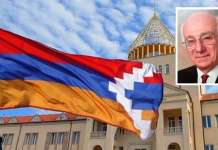If a talented writer had been commissioned to come up with a screenplay about a perfect disaster, perhaps he could not come up with a better scenario than the fate that befell Armenia in 1988. That year, a perfect trifecta struck — a crumbling Soviet Union and a raging war with Azerbaijan compounded by the earthquake measuring 7 on the Richter Scale in the dead of winter.
More than 300,000 Armenian refugees who had only recently escaped pogroms in Baku and Sumgait had to face yet another tragedy in Armenia following the earthquake.
For the last 100 years, Armenians have lamented about the forgotten genocide and for the last quarter century we added more to our miseries — the trauma of a forgotten earthquake. In the aftermath of the Genocide, Gumri, which was known as Alexandropol at the time — accepted hundreds and thousands of Armenian orphans, who later in 1926 had to experience a similar earthquake.
On December 7, 1988, the earthquake rocked the entire province of Shirak for 41 seconds, with the epicenter in the town of Spitak, leveling 80 percent of buildings and killing 25,000 people according to the official count, while other sources cited a higher number of casualties— 150,000 people dead or injured and more than 514,000 left homeless.
The earthquake also destroyed 40 percent of Armenia’s industrial infrastructure, from which the country has not fully recovered to this day.
A population of 300,000 in the region had been reduced to 120,000, many having left the misery behind in hopes of a better life in Russia.
The poverty level among the remaining population is at 46 percent, greater than any other region in Armenia.
One may ask why these people continue living there, under such difficult circumstances. Are they so patriotic and attached to the land that moving out is out of the question or is it a matter of not being able to afford the move? The first probability could be more rewarding, but the truth points to the latter.
The Soviet deputy chief of staff of civil defense, Maj. Gen. Nikolai Tarakanov, who two years prior to 1988 had been assigned to direct relief efforts in Chernobyl after that region’s devastating nuclear disaster, and was in Armenia to oversee the recovery efforts, stated, “Spitak proved to be much more terrible than Chernobyl.”
At one point, the tragedy captured the headlines of the global news media. One hundred and thirteen counties rushed humanitarian aid and rescue equipment and personnel and medical supplies. USSR leader Mikhail Gorbachev allocated 5 billion rubles (about $8 billion) for reconstruction, which was supposed to be completed in two years. Yet, after 27 years, the misery continues and the collapse of the Soviet Empire is not the only reason for that delay.
The timing of the quake was such that it was clear at that point that the Soviet Union, if not unraveling, was undergoing a major shift. It was still a closed world and with this disaster, some nations, including the US, were able to provide help while using the situation for a public relations gain.
Diaspora Armenians, shocked perhaps that their tiny nation was in the spotlight for the worst possible reason, contributed wholeheartedly and significantly, even after witnessing cynical abuse and profiteering by some government officials.
Since the earthquake in Armenia, many other earthquakes and natural disasters have taken place, grabbing headlines in their turn — Mexico, Japan, Nepal, Iran just to name a few — and the continuing misery in the disaster region of Armenia was forgotten. Also, it seems that people affected by those other calamities, similarly devastating, have been able to get back on their feet much more quickly.
Every time I visit Armenia and express a desire to see Gumri, people look quizzically at my face, as if asking, “what’s to see in Gumri?” My answer is if nothing, I wish to empathize with the people, to share their pain and their aspirations and find out if there is any light at the end of the tunnel.
Misery in Armenia has different mathematics, depending on whom you ask. According to government statistics, there are 965 families who need housing in the provinces of Shirak and Lori and it is believed that the government will meet their needs during 2015-16.
Since 2008, the government has allocated more than $200 million for housing reconstruction. But in reality, there are still 4,500 homeless families living in subhuman conditions in the domiks (temporary metal shacks). Of the total homeless families, 433 are on the government waiting list and 3,500 are not on that list for a variety of reasons — whether they have left for work in Russia temporarily and they are back or the families have outgrown their current housing. Indeed, after 27 years, children are grown, have formed their own families, and are still using the old existing facilities. Although this natural growth contributes to the number of dwindling population of Armenia, the government does not assume responsibility for their plight, because they are not direct victims of the earthquake. Yet they remain the casualty of the situation. If their names are not recorded on paper, their bodies are still sheltered in substandard abodes.
The former prime minister, Tigran Sargsyan, had pledged in 2008 that by 2013, the housing problem would be resolved. Three years after that deadline, the problem continues to fester. One has to ask if there is the will or the ability to get ahead of the situation once and for all.
There have been admirable changes in Gumri, including the inflow of artists to the city, which is much cheaper than the capital. Still, it is not enough as housing is not adequate.
Last October, the mayor of Gumri, Samvel Balasanyan, vowed to forgo his salary as long as there was a single resident living in makeshift housing.
Of course, we do not need to shed tears for Mr. Balasanyan’s livelihood, knowing full well that no government official in Armenia survives only on their salary. However, it is a symbolic gesture to boost the morale of the destitute citizens.
The scope of devastation was beyond Armenia’s capacity to cope. Even countries with more developed economies would have been hard pressed to deal with the situation.
There are some organizations trying to improve the situation, such as Shant TV Channel, which is engaged in fundraising in Armenia and Russia to contribute its share to the reconstruction and revival of northern Armenia. On the other hand, there is an indifferent and insensitive majority who is consumed by its own plight and Gumri does not even exist in its mental geography.
I know some oligarchs who have built opulent residences worth upwards of $20 to $30 million and they have not contributed a penny to Gumri nor do they intend to contribute to the needs there. It takes a special mindset and psychological firewall to be able to live comfortably in that kind of gaudy opulence, when 100 miles away people are freezing in the winter cold.
Every Armenian who cares about the country’s future has to visit Gumri. If touristic sites, churches, plush restaurants, and nightclubs are part of our homeland, then Gumri is part of our homeland too. If the visitors cannot contribute in any material way to the amelioration of the disaster area, if they cannot warm the bodies of the homeless, at least they can warm their souls, by showing that their brothers and sisters have not been forgotten and abandoned, even if the rest of the world has turned its back on them.















